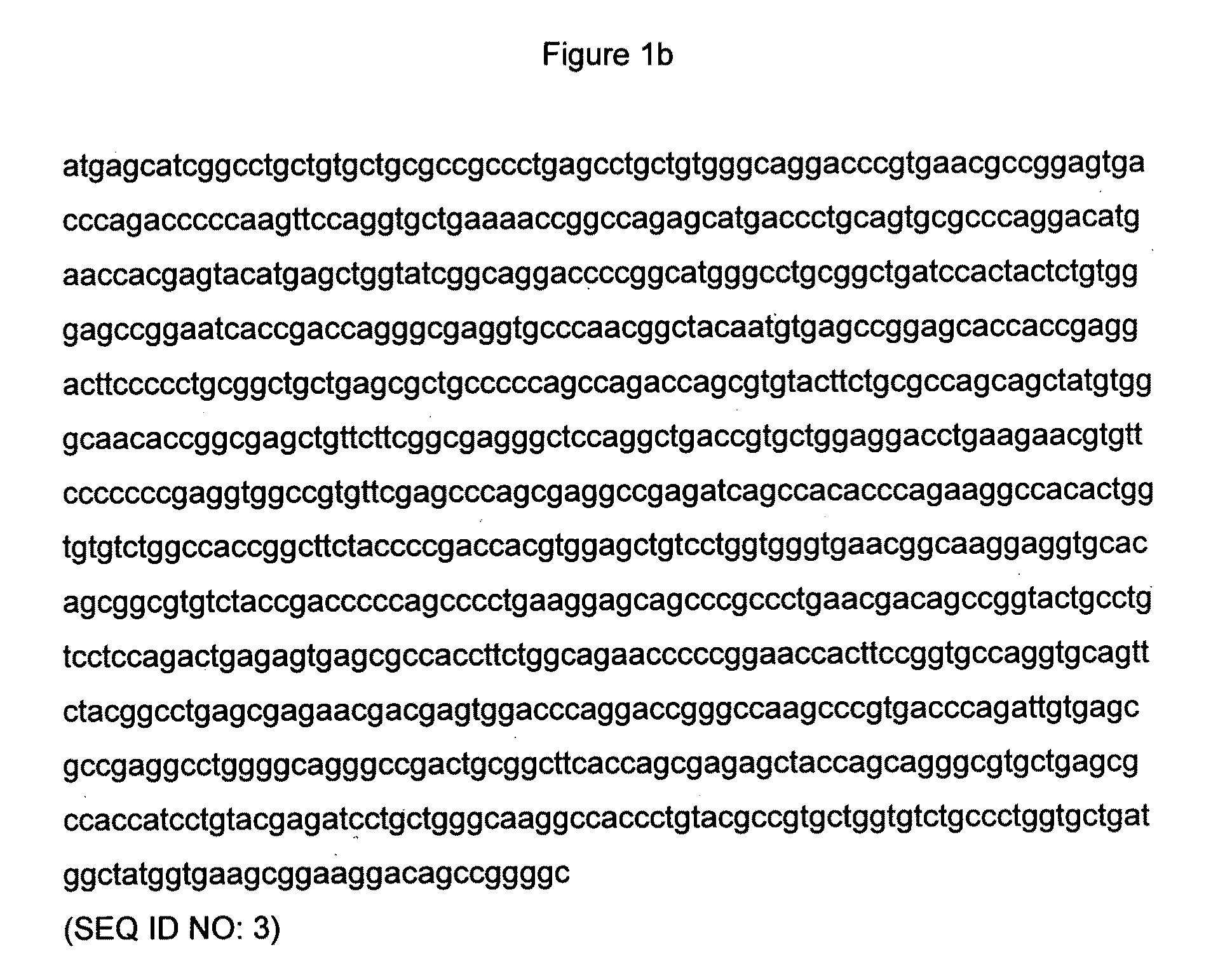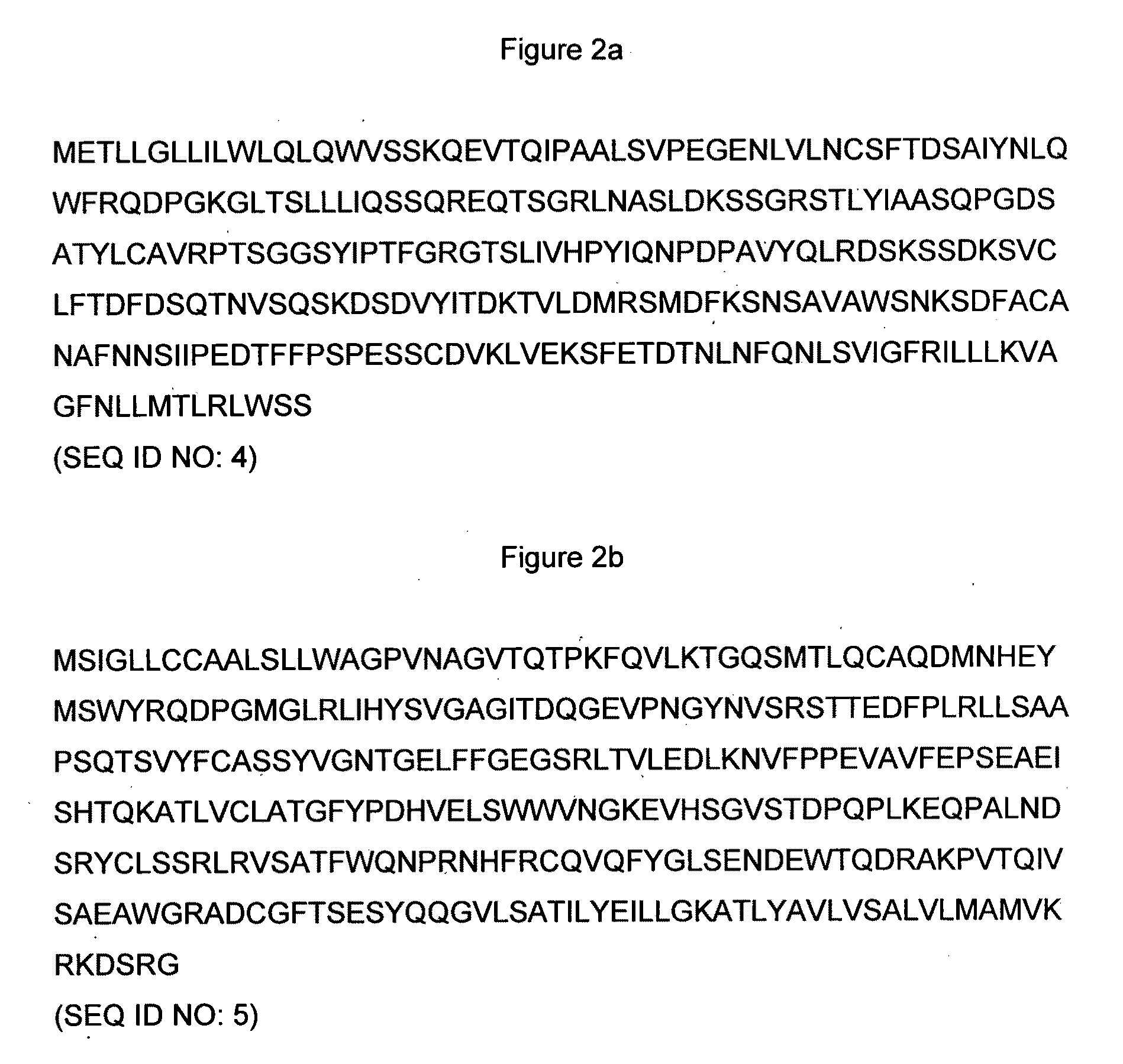T cell therapies
- Summary
- Abstract
- Description
- Claims
- Application Information
AI Technical Summary
Benefits of technology
Problems solved by technology
Method used
Image
Examples
example 1
Production of Soluble Disulfide Linked Versions of 1G4 NY-ESO and HIV Gag TCRs
[0073]FIGS. 3a and 3b provide the DNA sequences of the TCR alpha and beta chains of a soluble version of the wild-type 1G4 NY-ESO TCR. Each of these DNA sequences contains an introduced cysteine codon which is underlined.
[0074]FIGS. 7a and 7b provide the DNA sequences of the TCR alpha and beta chains of a soluble version of the wild-type HIV Gag TCR. Each of these DNA sequences contains an introduced cysteine codon which is underlined.
[0075]These DNA sequences can be synthesis de-novo by a number of contract research companies, for example GENEART AG (Germany).
[0076]Restriction enzyme recognition sites can be added to these DNA sequences in order to facilitate ligation of these DNA sequences into expression plasmids. pGMT7-based expression plasmids, which contain the T7 promoter for high level expression in E. coli strain BL21-DE3(pLysS (Pan et al., Biotechniques (2000) 29 (6): 1234-8)) are appropriate exp...
example 2
Biacore Surface Plasmon Resonance Characterisation of sTCR Binding to Specific pMHC
[0085]A surface plasmon resonance biosensor (Biacore 3000™) was used to analyse the binding of a sTCR to its peptide-MHC ligand. This was facilitated by producing single pMHC complexes (described below) which were immobilised to a streptavidin-coated binding surface in a semi-oriented fashion, allowing efficient testing of the binding of a soluble T-cell receptor to up to four different pMHC (immobilised on separate flow cells) simultaneously. Manual injection of HLA complex allows the precise level of immobilised class I MHC molecules to be manipulated easily.
[0086]Biotinylated class I HLA-A*0201 molecules were refolded in vitro from bacterially-expressed inclusion bodies containing the constituent subunit proteins and synthetic epitope peptide, followed by purification and in vitro enzymatic biotinylation (O'Callaghan et al. (1999) Anal. Biochem. 266: 9-15). HLA-A*0201-heavy chain was expressed with...
example 3
Production of Codon Optimised DNA and RNA Encoding Full Length 1G4 NY-ESO and HIV Gag TCRs
[0099]FIGS. 1a and 1b provide the DNA sequences of the TCR alpha and beta chains of codon-optimised full-length wild-type 1G4 NY-ESO TCR.
[0100]FIGS. 5a and 5b provide the DNA sequences of the TCR alpha and beta chains of codon-optimised full-length wild-type HIV Gag TCR.
[0101]These DNA sequences can be synthesis de-novo by a number of contract research companies, for example GENEART AG (Germany).
[0102]Restriction enzyme recognition sites can be added to these DNA sequences in order to facilitate ligation of these DNA sequences into appropriate gene expression vectors. Examples of such appropriate gene expression vectors include retroviral vectors such as derivatives of the MSCV-based splice-gag vector (pMSGV) which is described in Hughes et al., (2005) Hum Gene Ther. 16: 457-472. Retroviral packaging and T cell transduction can then be carried out according to Zhao et al. (2005) J Immunol. 174:...
PUM
| Property | Measurement | Unit |
|---|---|---|
| Time | aaaaa | aaaaa |
| Time | aaaaa | aaaaa |
Abstract
Description
Claims
Application Information
 Login to View More
Login to View More - R&D
- Intellectual Property
- Life Sciences
- Materials
- Tech Scout
- Unparalleled Data Quality
- Higher Quality Content
- 60% Fewer Hallucinations
Browse by: Latest US Patents, China's latest patents, Technical Efficacy Thesaurus, Application Domain, Technology Topic, Popular Technical Reports.
© 2025 PatSnap. All rights reserved.Legal|Privacy policy|Modern Slavery Act Transparency Statement|Sitemap|About US| Contact US: help@patsnap.com



